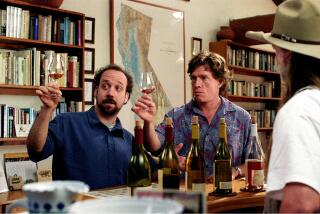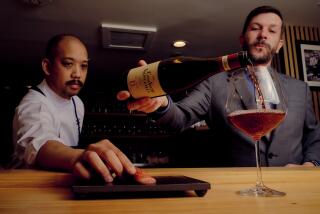Kiwi Wine From the Far South
- Share via
QUEENSTOWN, New Zealand — A group of pioneering winemakers has defied skeptics by producing promising wines from the world’s most southerly vineyards--latitude 45 degrees--in Central Otago, toward the southern end of South Island, New Zealand.
“The experts all advised me not to bother, saying it’s too cold,” says Alan Brady, one of the winemakers.
Brady began experimenting in Central Otago during the mid-1980s, 10 years after planting began in the Marlborough region at the north end of South Island. Marlborough is most responsible for New Zealand’s growing reputation as a producer of fine wines.
“Before then,” Brady says, “people were saying there would never be wine produced south of the Cook Strait [which separates the two islands that make up New Zealand].” But I felt [Central Otago] was a good climate for growing grapes; it’s dry and hot in summer and cold and dry in winter.”
The Central Otago vineyards are on the banks of the Kawarau River, in a spectacular gorge near Queenstown. Here in New Zealand’s deep south, lakes nestle beside craggy, snow-capped mountains and rivers cut through arid plains. Planting has increased dramatically during the last two years, and there are now 20 vineyards in the region.
One of the biggest new investors in the region is New Zealand actor and “Jurassic Park” star Sam Neill. With cricket master batsman Martin Crowe, he has invested in the fledgling wine region and believes that it has huge potential.
“The initial overseas thrust by the New Zealand wine industry was spearheaded with Sauvignon Blanc from Marlborough,” Neill said in a recent magazine article. “It is my belief that the next drive will be headed by Pinot Noir from Central Otago.”
The latitude is the equivalent of France’s Bordeaux region in the Northern Hemisphere, and Brady likens much of the Otago area to Germany’s Rhine region. The region has huge climatic variations, with summer temperatures often soaring above 95 and in winter falling to 5 below zero. To counter the extremes in temperature, particularly high day-night variations, Brady has built a cellar 50 yards deep to provide a stable environment in which the wines mature.
There’s no doubt that fine wines have been produced. The question is how much of a player Central Otago will be. Wine writer and critic Keith Stewart believes that with only about 500 acres of grapes planted, and little extra suitable land, it will not become a significant New Zealand wine region.
“I think finding enough suitable land for planting grapes will be the problem for the region,” Stewart says. “I think it will always be an extension of the region’s tourism business, although I don’t say some won’t make good wine.
“So far, we have got some pretty good Pinot Noirs coming out of there, but little else. It’s too young to tell.”
Stewart also believes that prices charged for the good wines are too high compared with similar wines from other regions.
Still, Brady expects Central Otago to develop a distinct identity because of its climate and 1,000-foot altitude. “There was an early wave of the romantic enthusiasts like me,” he says, “and we are now experiencing the second wave of serious investors from outside the region who have the funds to buy land ripe for viticulture and establish good-sized vineyards, well set up from day one.”
He expects it may be 20 to 30 years before Central Otago identifies the right varieties to grow. But the region is already on the map for international wine critics.
“They are excited about us as a region that is very different from any other region in New Zealand,” Brady says, “because of our isolation and because we are the furthest south, of course.”
More to Read
Sign up for The Wild
We’ll help you find the best places to hike, bike and run, as well as the perfect silent spots for meditation and yoga.
You may occasionally receive promotional content from the Los Angeles Times.






